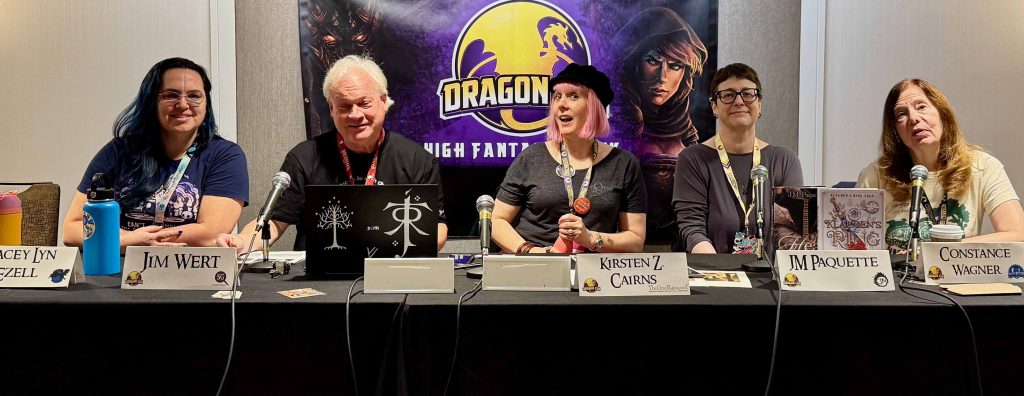The High Fantasy track closed out its Dragon Con 2025 schedule with an examination of the final chapter in J.R.R. Tolkien’s The Lord of the Rings. “The Scouring of the Shire” panel brought together Kacy Lyn Ezell, Alicia Fox Lenz, Kristin Cairns, and Constance Wagner to Marriott L401-403 on Monday at 11:30AM to discuss the place, purpose, and ultimate meaning of this final crisis. Jim Wert, always the thoroughly prepared moderator, used a series of visuals and slides to wonderful effect as he guided the panel through the topic.

Except for an allusion to it, Peter Jackson’s film adaptation did not tell the story of this final assault on the Hobbits’ beloved Shire. The first question to the panel was why? Why leave it out? The most obvious answer to anyone who has seen the film was that it already had several endings! More than that, Cairns pointed out, we are used to stories that reach an epic climax and then end peacefully. The scouring of the shire is anything but that. In that chapter the evil of Mordor has been brought to the Shire by the fallen wizard Saruman. Aided by Grima Wormtongue, he has despoiled the land, poisoned the water, and abused the simple, peaceful, hobbits. Frodo and his companions must grapple with this final assault, and it is a very difficult moment. While Tolkien was adamant that this final chapter was always part of the plan for the book, it is interesting to consider that in his earlier drafts of the text his title was actually “The Mending of the Shire.” The replacement of the word “mend” with “scour” carries meaningful connotations that emphasize the need to cleanse before one can heal.
Cairns offered an interesting answer to the question of Tolkien’s reasoning behind including it. She sees the chapter as fundamentally an exercise in restoration. The Shire must be not just repaired but restored. She sees Tolkien trying to turn back the clock, which we all know is not possible in real life. For her, this chapter is an exercise in “a bit of wish fulfillment” on the part of its author.
The idea that you can’t go back to the way it was before resonated for Ezell, a military veteran. Frodo and his companions sacrificed hearth, home, and peace for danger, deprivation, and war all in the quest to destroy the ring, and each has been transformed by the experience. They are not the same hobbits who left the shire twelve short months ago, and because of their trauma, they may not be able to truly “go home.” What they can do, she insisted, is make home where they are. The hobbits are veterans changed by the trauma of war and wounded in ways that, as Gandalf tells Frodo during the journey back to the shire, “can never fully heal.”
In Tolkien’s earlier drafts of the chapter, it is Frodo the grizzled warrior who kills Sharkey the evil overlord. Ten years passed between that draft and the final one. Wagner pointed out that Tolkien, as a writer, continued to grow as an artist and creator, which led him to change Frodo. In the final draft Frodo calls for Sharkey (who is Saruman) to be spared in the hope of redemption.
This final story of change, growth, redemption (or at least the hope of it), and death gives the reader, according to Cairns, closure. “Let’s be honest” she declared, “if it weren’t there, you’d all wonder what happened when they got home.” Everyone in attendance wholeheartedly agreed. It was an outstanding way to close out Dragon Con 2025.
